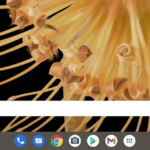
With the upcoming version 13, Google makes its mobile operating system suitable for use on desktop and notebook PCs. In the second developer preview that has now been released, there are corresponding characters in the form of controls aimed at the PC. The American Android specialist Mishal Rahman who has made it his job to document all the changes to Android is currently tearing apart Android 13 Developer Preview 2, which was released yesterday documented for his employer’s blog Esper.io also about changes to make it easier to use Android 13 on PCs.
As Rahman explains in his blog post, Android 13 with the DP2 gets some extra buttons for the first time to make it easier to use on a PC. Among other things, Google introduces an expanded launcher toolbar with Android 13, on which icons for quick access to notifications and quick settings are now displayed on the right edge of the screen, almost like under Windows.
The new buttons appear exactly where other devices with larger screens usually place Android’s three-button navigation. In addition, Rahman noted that all apps in the Android 13 DP2 on PCs are now always opened in freeform mode, that is, freely customizable. This allows the user to move the windows back and forth directly and effortlessly on the “desktop”. Multi-window control is always enabled, allowing you to work with multiple programs in window mode on the desktop just like under Windows. However, it is currently unclear whether Google will actually be able to officially use the freeform window mode with Android 13 in the final version. It was already introduced with Android 7.0 but is still hidden behind a developer option.
Also, it’s unclear at this point what strategic purpose the tweaks to Android 13, which have been highly manageable so far, actually have for use on PCs. So far, there have been some instances where Android has already been used as the PC operating system, but actually, Google is still fully committed to Chrome OS as the preferred operating system for notebooks and desktop computers. Incidentally, the screenshots published by Rahman were not taken on a PC, but on a Pixel 6 Pro, in which in the PC version he activated the corresponding flags for the surface output and increased the pixel density.
Digital marketing enthusiast and industry professional in Digital technologies, Technology News, Mobile phones, software, gadgets with vast experience in the tech industry, I have a keen interest in technology, News breaking.